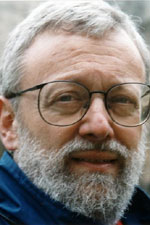Abstracts

“A Historian of Science Acquires His Tools”
October 3, 2014
Location: Valley Library, Oregon State University. Watch Video | Download Transcript (PDF)
In interview 1, Farber discusses his early upbringing in New York City, his family background, and the impact that religion made in his household as a child. From there he describes the family's move to Uniontown, Pennsylvania, his first interests in science, and his underwhelming high school experience in western Pennsylvania.
Farber then recounts his college experiences, first as an undergraduate at the University of Pittsburgh. Farber notes his adjustment to college life, his academic progression, the impact that a summer NSF institute made on the course of his studies, and his memories of meeting Vreneli Marti and her extraordinary family. His years as a graduate student at Indiana University are the next focus of the session, including his decision to attend IU and the scholarly environment that he found there. Farber also recounts the development of his interests in Comte de Buffon and ornithology during his graduate years.
A major component of the session is Farber's analysis of the means by which he required his scholarly toolkit as a historian. In this, Farber describes the ways in which he has managed to navigate large volumes of material in a variety of languages. He also shares his memories of early archival experiences in Paris.
The final portion of the interview is devoted to a discussion of Farber's job search following the completion of his Ph.D., his first impressions of western Oregon, his ultimate decision to come to OSU, and the state of the university at that time. Farber describes the climate at OSU in the early 1970s, including his unusual circumstance of working as a historian in the General Science department. Farber also recalls the process by which he learned the craft of teaching and describes the means by which he chose to pursue history over philosophy in the first place. The session concludes with Farber's impressions of OSU's ambition in the early 1970s and the low expectations that many of the era's faculty and administrators maintained for the institution.

“One Department Closes, Another is Revitalized”
October 13, 2014
Location: Valley Library, Oregon State University. Watch Video | Download Transcript (PDF)
Interview 2 begins with Farber's thoughts on two high-profile OSU historians, William Appleman Williams and Bill Robbins, as well as a former OSU President, Robert MacVicar. Farber next describes his early research agenda while an OSU faculty member, including details of his work on the history of ornithology and the research trips that he took to Paris and London in support of the work. In this discussion, Farber emphasizes the importance of identifying a historical problem that needs answering as one develops a focus of their research. He also reflects on the actual writing of history, speaking to the historian's anxiety at having missed something important as well as the difficulties of crafting prose that is a pleasure to read.
The session next shifts its attention to Farber's involvement with the Humanities Development Program at OSU, an experience that helped prompt his later interest in serving as an administrator. He describes the means by which he became chair of General Science and notes a few successes of that period, including the creation of an Environmental Science program. Farber likewise notes the uneasy relationship between History of Science - a component of the General Science department at the time - and the History department during his tenure as chair of General Science.
The dissolution of General Science in the wake of Oregon Ballot Measure 5 is the next major topic of the interview. From there, Farber recounts the circumstances that led to his becoming chair of the History department, and the ways in which the department evolved under his leadership. An important moment in department history came in 1994 with the creation of the Horning Chair, and Farber recalls the recruitment and hiring of a married couple, Mary Jo Nye and Bob Nye to fill the position. He also reflects on the significant impact that the Nyes made during their careers at OSU.
The interview then turns its attention to Farber's book Finding Order in Nature, as well as a discussion of his work on evolutionary ethics and race-mixing, both hot button issues in American culture. The session concludes with Farber's thoughts on the current direction of Oregon State University, including the need for improvement in humanities education at the university and the broader imperative for improved funding of higher education state-wide.

